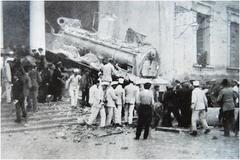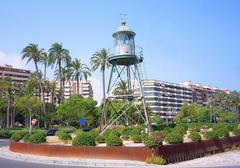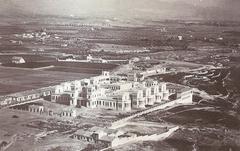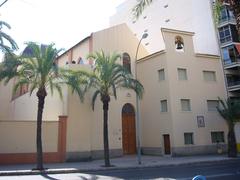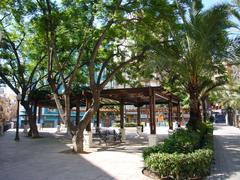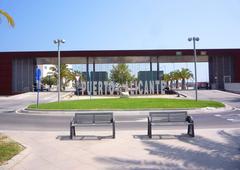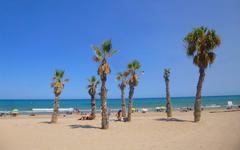Torre Ferrer Alicante: Visiting Hours, Tickets, and Tourist Guide
Date: 14/06/2025
Introduction
Torre Ferrer is a remarkable historical tower located in Alicante, Spain, and forms part of the region’s distinctive “Torres de la Huerta” network. Erected during the 16th or 17th century in response to Mediterranean pirate threats, Torre Ferrer was designed as a defensive structure to protect agricultural lands and local communities. Today, it stands as an enduring symbol of Alicante’s resilience, strategic ingenuity, and rich cultural heritage. This comprehensive guide details Torre Ferrer’s history, architecture, visiting information, preservation efforts, practical tips, and nearby attractions—providing everything you need for an enriching visit (Castillos de España; CastillosRicsol; Red Fedora Diary).
Table of Contents
- Historical Background of Torre Ferrer
- Architectural Features and Construction
- Torre Ferrer’s Role in Alicante’s Defensive Network
- Cultural Significance and Preservation
- Practical Visitor Information
- Accessibility Considerations
- Conservation and Future Prospects
- Frequently Asked Questions (FAQ)
- Conclusion and Call to Action
- References
Historical Background of Torre Ferrer
Torre Ferrer is part of the “Torres de la Huerta,” a network of watchtowers that protected Alicante’s agricultural plains from Berber pirate raids between the 16th and 18th centuries. These towers provided early warnings and shelter to local populations, reflecting a period when coastal communities required vigilance and quick communication. While Torre Ferrer’s exact construction date is uncertain, its military architectural style and historical context place it firmly in the era of heightened Mediterranean piracy (Castillos de España).
Architectural Features and Construction
Torre Ferrer exemplifies practical military architecture:
- Structure: Typically rectangular or square, rising two to three stories with thick limestone and lime mortar walls often over a meter thick.
- Defensive Elements: Elevated entrance accessible by ladder, minimal and high-placed windows, flat roof with parapet for surveillance and signaling.
- Interior: Lower floors for storage and supplies, upper floors for living quarters and observation; narrow staircases or ladders for added security.
- Materials: Constructed with locally sourced stone, wooden beams, and iron-reinforced doors, blending with the regional landscape.
This robust design allowed Torre Ferrer to withstand attacks and serve as a refuge for both the landowners and the local community (Castillos de España).
Torre Ferrer’s Role in Alicante’s Defensive Network
Torre Ferrer was integral to a network of towers spaced across the “huerta” (fertile plain), enabling visual communication and rapid alerts. This early warning system connected rural areas with major fortifications like the Castillo de Santa Bárbara, allowing coordinated defense and fostering the region’s agricultural prosperity (Castillos de España).
Cultural Significance and Preservation
Recognized as a Bien de Interés Cultural (BIC), Torre Ferrer is protected by law and valued as a symbol of Alicante’s layered history, blending Christian, Muslim, and subsequent influences. Preservation initiatives, often led by local authorities and heritage organizations, focus on stabilization, restoration, and community engagement. Despite urban encroachment, Torre Ferrer continues to serve as an educational resource and a link to Alicante’s past (Castillos de España; Alicante Heritage Association; informacion.es).
Practical Visitor Information
Location and Accessibility
- Address: Calle Licia Calderón, La Condomina, Alicante.
- Transport: Accessible by public transport (nearest Tram-via stop at the Golf Course recreational area), local bus, car, or taxi. Approximately 15–20 minutes from Alicante city center by car.
Visiting Hours and Tickets
- General Access: The tower’s interior is not open to the public; exterior viewing is possible at any time.
- Special Openings: As of 2024, occasional open days and guided tours are organized, typically on weekends and public holidays, from 10:00 AM to 6:00 PM. Guided tours require advance booking via the Alicante tourism office (Alicante Tourism Board).
- Tickets: Exterior viewing is free; guided tours and events may involve a fee.
Guided Tours and Events
- Guided tours, when available, offer in-depth historical and architectural insights.
- Cultural events and workshops are occasionally scheduled, especially during local festivals or heritage days.
Tips for Visitors
- Combine with Cycling/Walking Route: Torre Ferrer is a highlight of the “Torres de la Huerta” cycling route, ideal for exploring multiple towers (The Costa Blanca Guide).
- Best Time to Visit: Spring and autumn offer comfortable weather for walking or cycling.
- Photography: Optimal light in early morning or late afternoon. The setting provides a contrast between historic and modern architecture.
- Facilities: No on-site amenities; nearby neighborhood offers cafes and shops.
- Language: Information panels are in Spanish; translation apps are helpful.
- Safety: Respect fencing and signage; do not attempt to climb or enter the structure.
Nearby Attractions
- Castillo de Santa Bárbara: Offers panoramic views and historical exhibitions.
- MARQ (Museo Arqueológico de Alicante): Features displays on local heritage, including the towers.
- Santa Faz Monastery and Alicante’s Old Town: Rich in history and cultural interest.
Accessibility Considerations
- Mobility: The immediate area has narrow sidewalks; the site is not wheelchair accessible.
- Virtual Tours: Online resources and virtual tours are available for those unable to visit in person (Castillos de España).
- Parking: Limited nearby; public transport is recommended.
Conservation and Future Prospects
- Restoration: Recent efforts have stabilized masonry and improved safety, but urban encroachment remains a challenge.
- Adaptive Reuse: Plans include developing Torre Ferrer as an interpretive center for the “Torres de la Huerta” and Alicante’s agricultural heritage.
- Digital Access: Expansion of virtual tours and online educational resources is underway.
- Community Engagement: Local heritage groups and schools are active in conservation and educational programs (Alicante Heritage Association).
Frequently Asked Questions (FAQ)
Q: What are Torre Ferrer’s visiting hours?
A: Exterior viewing is possible at any time. Guided tours or interior access, when available, are typically on weekends and public holidays from 10:00 AM to 6:00 PM. Always check ahead for updates.
Q: Do I need a ticket to visit Torre Ferrer?
A: No tickets are required for exterior viewing. Guided tours may involve a fee and require advance booking.
Q: Is Torre Ferrer wheelchair accessible?
A: No, the site is not wheelchair accessible due to its historic structure and urban surroundings.
Q: Are guided tours available?
A: Yes, through the Alicante tourism office—schedule and availability may vary.
Q: What is the best time of year to visit?
A: Spring and autumn for pleasant weather; early morning or late afternoon for photography.
Q: Are there facilities at the site?
A: No; nearby cafes and shops are available in the residential neighborhood.
Conclusion and Call to Action
Torre Ferrer is a vital part of Alicante’s historical and cultural landscape, embodying the city’s defensive past and architectural legacy. While public access is limited, the tower remains a compelling destination—especially when combined with the “Torres de la Huerta” route and other nearby attractions. Ongoing preservation, digital initiatives, and community involvement promise to further enhance its role as a cultural landmark.
Plan your visit today: Check the Alicante Tourism Board for up-to-date visiting hours, guided tours, and events. For personalized tips, interactive maps, and real-time updates, download the Audiala app. Join heritage efforts by respecting the site and supporting local conservation organizations.
References
- Castillos de España: Torre Ferrer
- Alicante Tourism Board
- CastillosRicsol: Torre Ferrer
- informacion.es: Desdenadas Torres de la Huerta Alicante
- Red Fedora Diary: Best Things to Do in Alicante Spain
- Alicante Heritage Association
